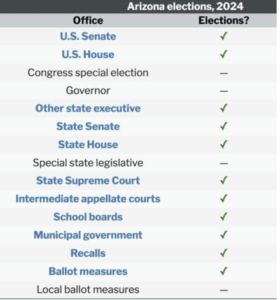Every position up for Election in Arizona

With the election rapidly approaching, we want to ensure you’re aware of every position up for election in Arizona. Below you’ll find detailed information about the positions that directly impact the Grand Canyon State!
Source: Ballotpedia
First, here are the positions on the ballot for Maricopa County for this November election!

So how does the state government work? Let’s let the state explain! STATE INFORMATION: (Source: Official Website of the State of Arizona)
Executive Branch:
- Governor: Head of the state, enforces laws, four-year
- Secretary of State: Oversees elections and records, four-year
- Attorney General: Chief legal officer, four-year
- State Treasurer: Manages state finances, four-year
- Superintendent of Public Instruction: Oversees public education, four-year
- Corporation Commissioners (5): Regulate utilities and businesses, four-year
- State Mine Inspector: Oversees mine safety, four-year
Legislative Branch:
- State Senate: 30 districts, one senator per district, two-year
- State House of Representatives: 30 districts, two representatives per district, two-year
terms.
Judicial Branch:
- Justices of the Peace: Handle small claims and misdemeanors, four-year
Most higher court judges are appointed but face retention elections.
Key Points:
- Governor, Secretary of State, Attorney General, Treasurer, and Superintendent of Public Instruction are the main elected executive positions.
- Corporation Commissioners and the State Mine Inspector are specialized elected
- State Senate and State House of Representatives are elected every two
- Justices of the Peace are elected at the judicial level, while higher courts use a merit system followed by retention elections.
